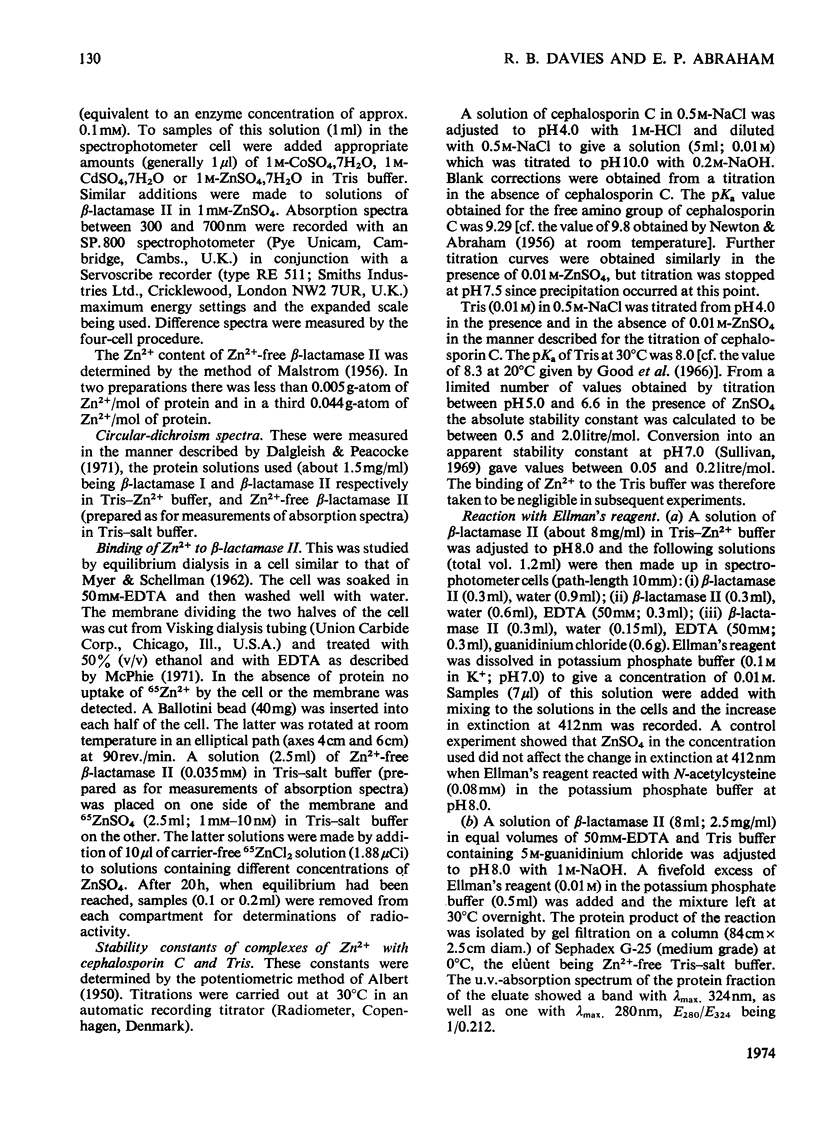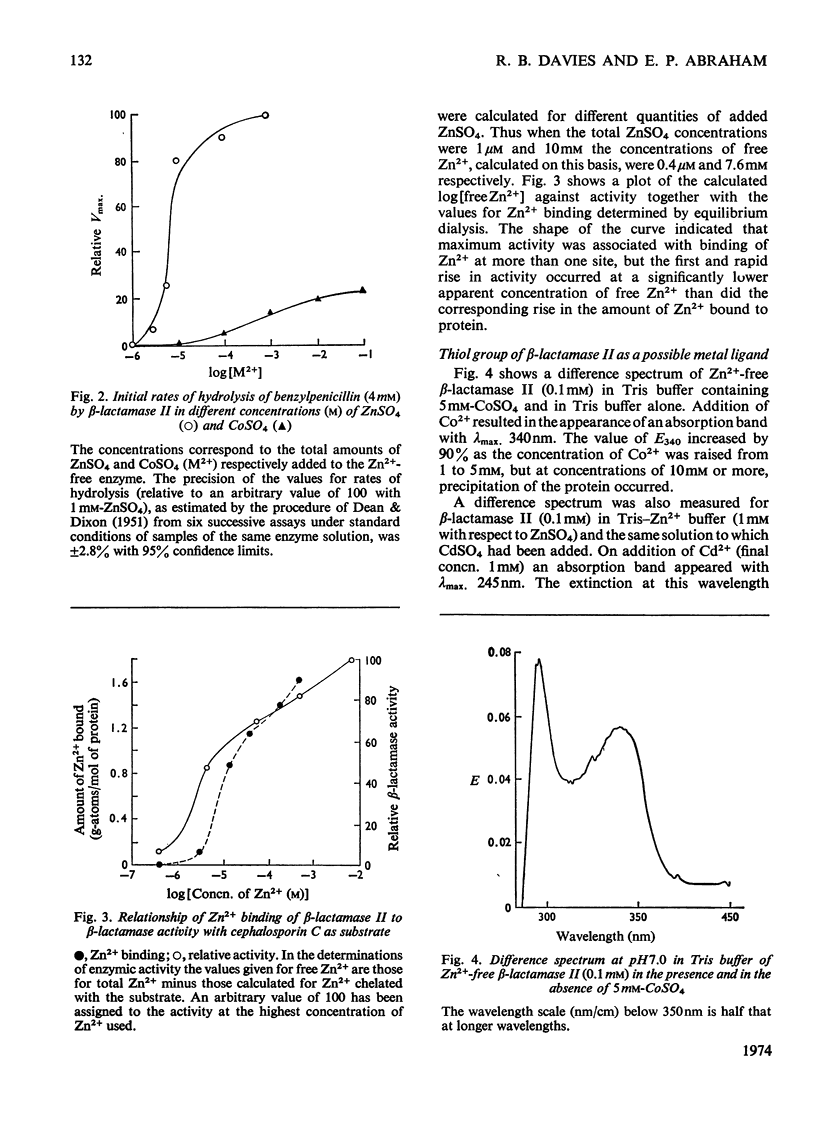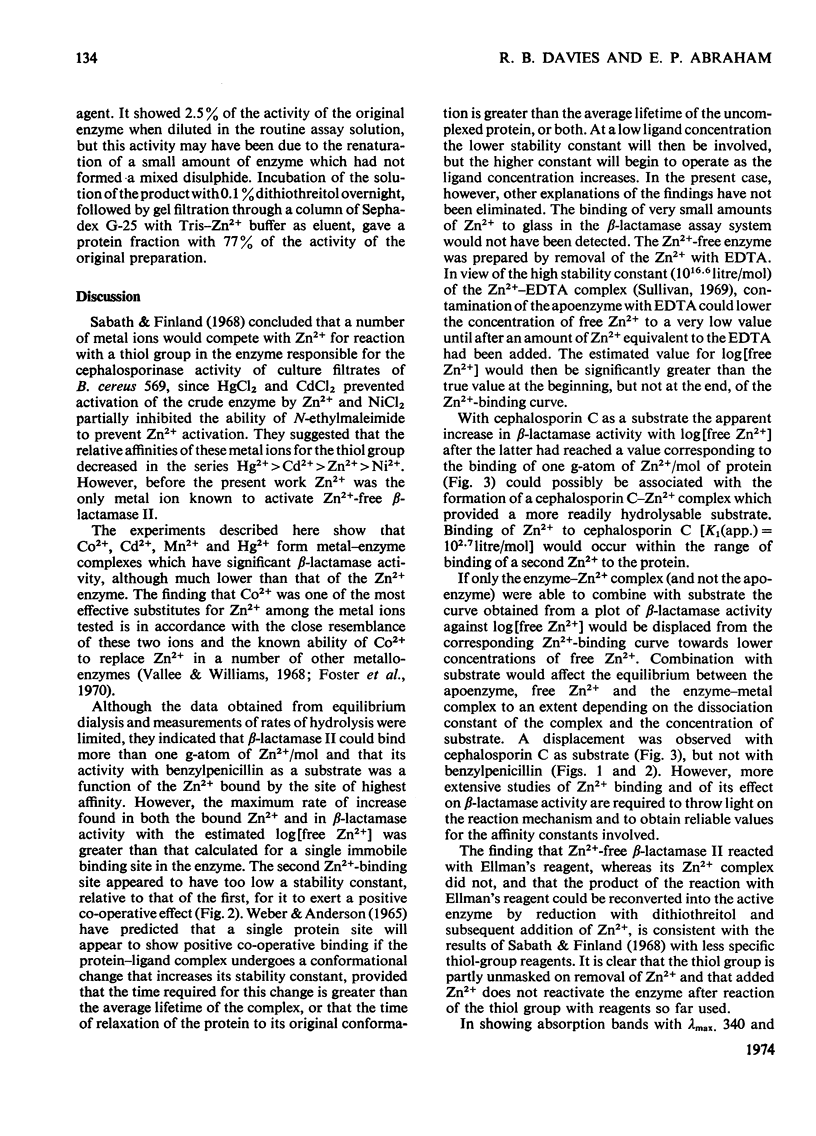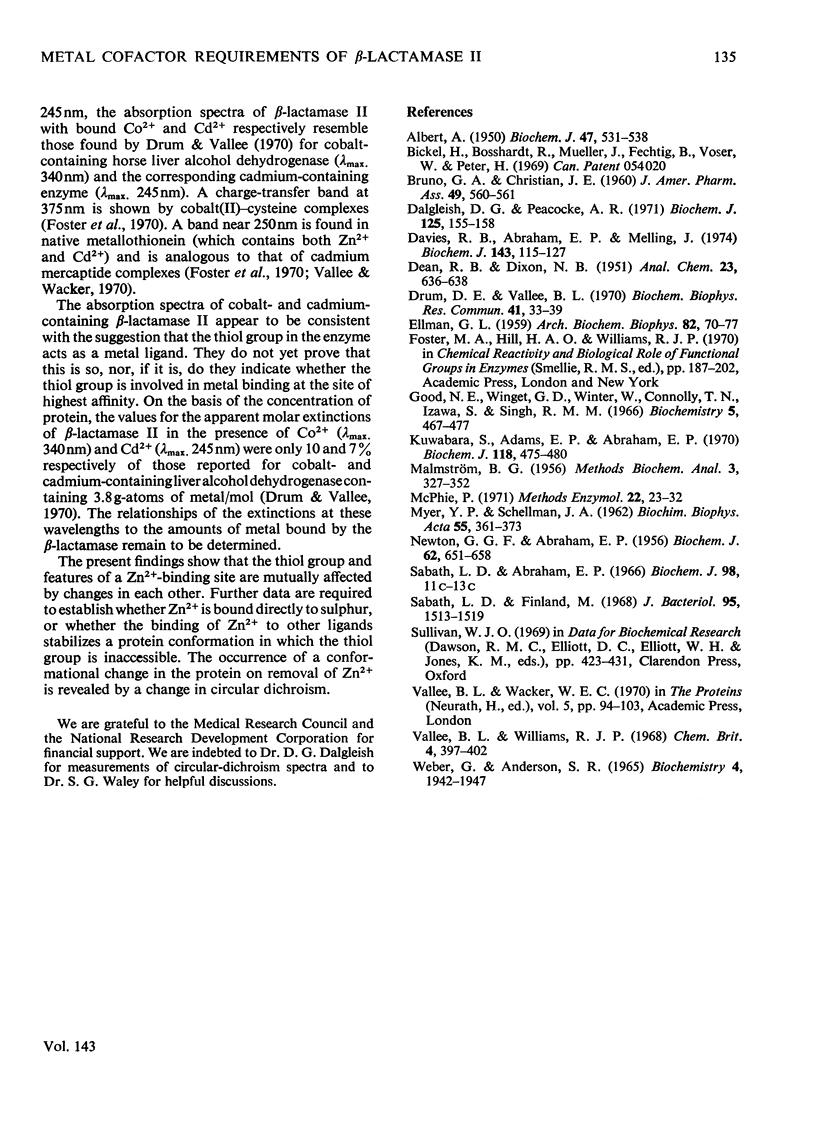Abstract
1. The apoenzyme obtained on removal of Zn2+ from β-lactamase II from Bacillus cereus 569/H/9 showed less than 0.001% of the activity of the Zn2+-containing enzyme. 2. Removal of Zn2+ led to a conformational change in the enzyme and partial unmasking of a thiol group. 3. Replacement of Zn2+ by Co2+, Cd2+, Mn2+ or Hg2+ gave enzymes with significant, but lower, β-lactamase activity. No activity was detected in the presence of Cu2+, Ni2+, Mg2+ or Ca2+. 4. Equilibrium dialysis indicated that the enzyme had at least two Zn2+ binding sites. With benzylpenicillin as substrate the variation in activity with concentration of Zn2+ indicated that activity paralleled binding of Zn2+ to the site of highest affinity. 5. Replacement of Zn2+ by Co2+ and Cd2+ gave enzymes with absorption bands at 340 and 245nm respectively, and raised the question of whether the thiol group in the enzyme is a metal-ion ligand. 6. Reduction of the product obtained by reaction of denatured β-lactamase II with Ellman's reagent [5,5′-dithiobis-(2-nitrobenzoic acid)] gave a protein which could refold to produce β-lactamase II activity in high yield.
Full text
PDF






Selected References
These references are in PubMed. This may not be the complete list of references from this article.
- ALBERT A. Quantitative studies of the avidity of naturally occurring substances for trace metals; amino-acids having only two ionizing groups. Biochem J. 1950 Nov-Dec;47(5):531–538. doi: 10.1042/bj0470531. [DOI] [PMC free article] [PubMed] [Google Scholar]
- BRUNO G. A., CHRISTIAN J. E. Note on suitable solvent systems usable in the liquid scintillation counting of animal tissue. J Am Pharm Assoc Am Pharm Assoc. 1960 Aug;49:560–561. doi: 10.1002/jps.3030490820. [DOI] [PubMed] [Google Scholar]
- Dalgleish D. G., Peacocke A. R. Circular-dichroism studies on two -lactamases from Bacillus cereus. Biochem J. 1971 Nov;125(1):155–158. doi: 10.1042/bj1250155. [DOI] [PMC free article] [PubMed] [Google Scholar]
- Davies R. B., Abraham E. P. Separation, purification and properties of beta-lactamase I and beta-lactamase II from Bacillus cereus 569/H/9. Biochem J. 1974 Oct;143(1):115–127. doi: 10.1042/bj1430115. [DOI] [PMC free article] [PubMed] [Google Scholar]
- Drum D. E., Vallee B. L. Optical properties of catalytically active cobalt and cadmium liver alcohol dehydrogenases. Biochem Biophys Res Commun. 1970 Oct 9;41(1):33–39. doi: 10.1016/0006-291x(70)90464-x. [DOI] [PubMed] [Google Scholar]
- ELLMAN G. L. Tissue sulfhydryl groups. Arch Biochem Biophys. 1959 May;82(1):70–77. doi: 10.1016/0003-9861(59)90090-6. [DOI] [PubMed] [Google Scholar]
- Good N. E., Winget G. D., Winter W., Connolly T. N., Izawa S., Singh R. M. Hydrogen ion buffers for biological research. Biochemistry. 1966 Feb;5(2):467–477. doi: 10.1021/bi00866a011. [DOI] [PubMed] [Google Scholar]
- Kuwabara S., Adams E. P., Abraham E. P. The composition of beta-lactamase I and beta-lactamase II from Bacillus cereus 569-H. Biochem J. 1970 Jul;118(3):475–480. doi: 10.1042/bj1180475. [DOI] [PMC free article] [PubMed] [Google Scholar]
- MALMSTROM B. G. Determination of zinc in biological materials. Methods Biochem Anal. 1956;3:327–352. [PubMed] [Google Scholar]
- MYER Y. P., SCHELLMAN J. A. The interaction of ribonuclease with purine and pyrimidine phosphates. I. Binding of adenosine 5'-monophosphate to ribonuclease. Biochim Biophys Acta. 1962 Mar 5;55:361–373. doi: 10.1016/0006-3002(62)90791-6. [DOI] [PubMed] [Google Scholar]
- NEWTON G. G., ABRAHAM E. P. Isolation of cephalosporin C, a penicillin-like antibiotic containing D-alpha-aminoadipic acid. Biochem J. 1956 Apr;62(4):651–658. doi: 10.1042/bj0620651. [DOI] [PMC free article] [PubMed] [Google Scholar]
- Sabath L. D., Finland M. Thiol-group binding of zinc to a beta-lactamase of Bacillus cereus: differential effects on enzyme activity with penicillin and cephalosporins as substrates. J Bacteriol. 1968 May;95(5):1513–1519. doi: 10.1128/jb.95.5.1513-1519.1968. [DOI] [PMC free article] [PubMed] [Google Scholar]
- Vallee B. L., Williams R. J. Enzyme action: views derived from metalloenzyme studies. Chem Br. 1968 Sep;4(9):397–402. [PubMed] [Google Scholar]


